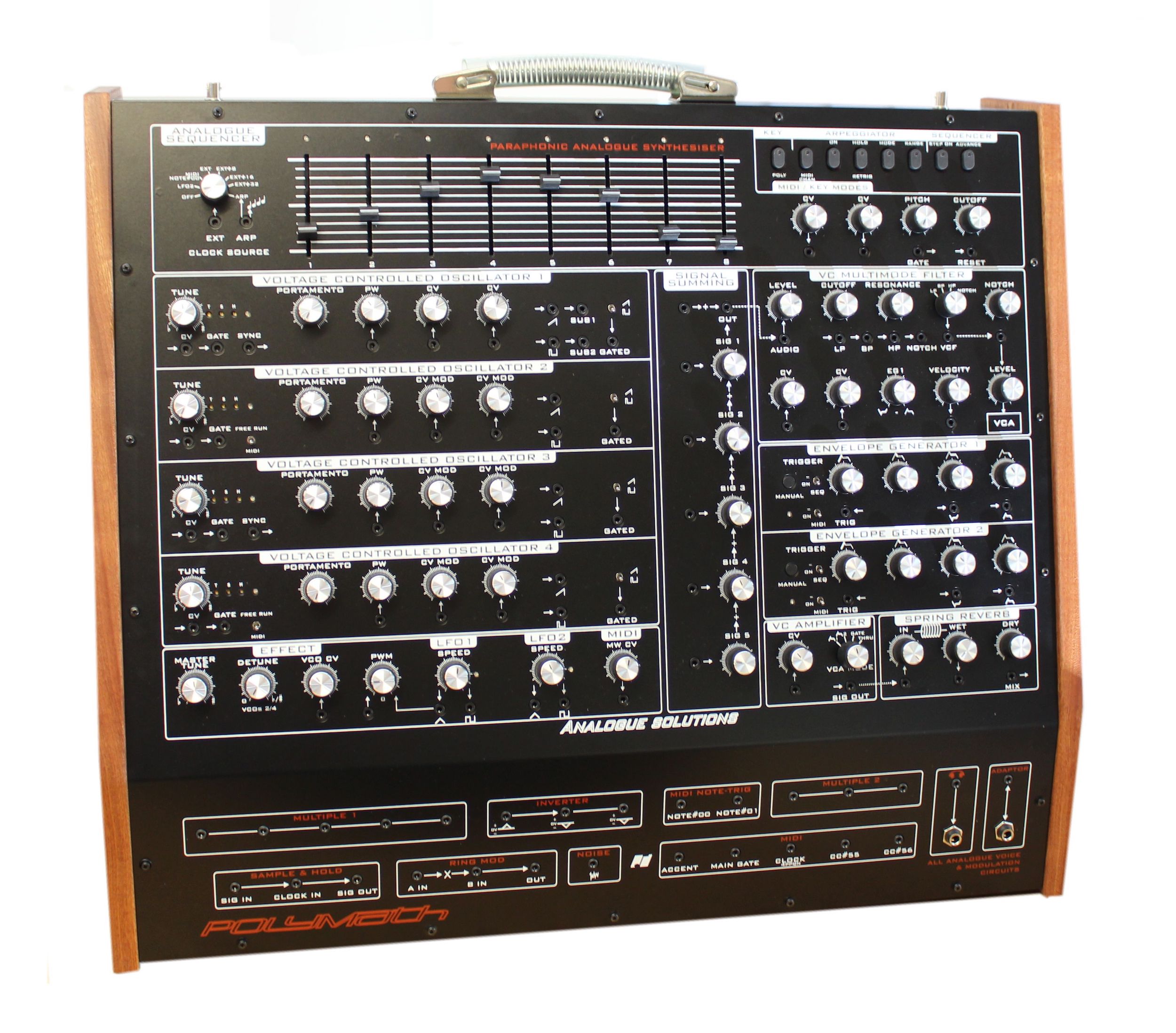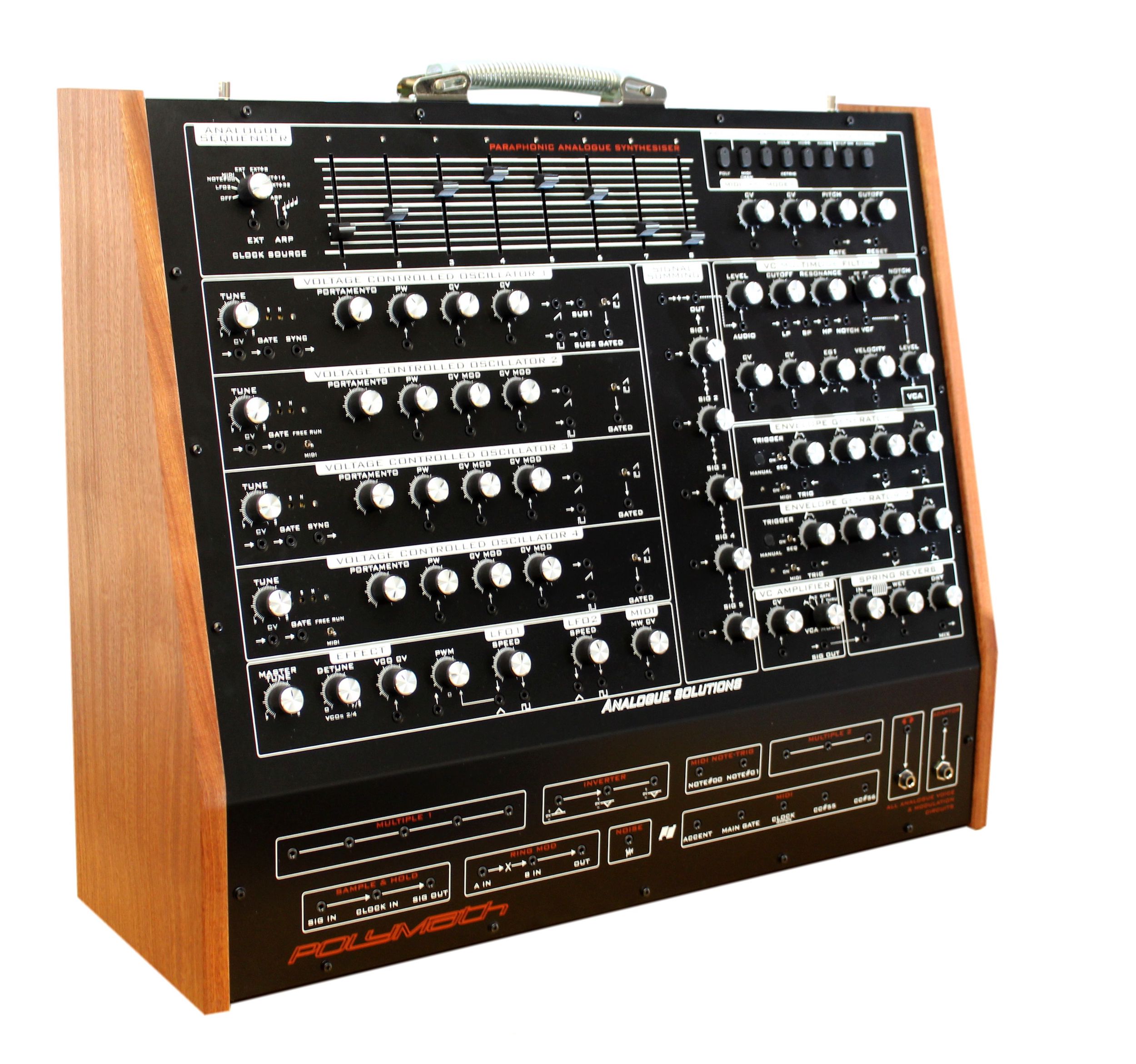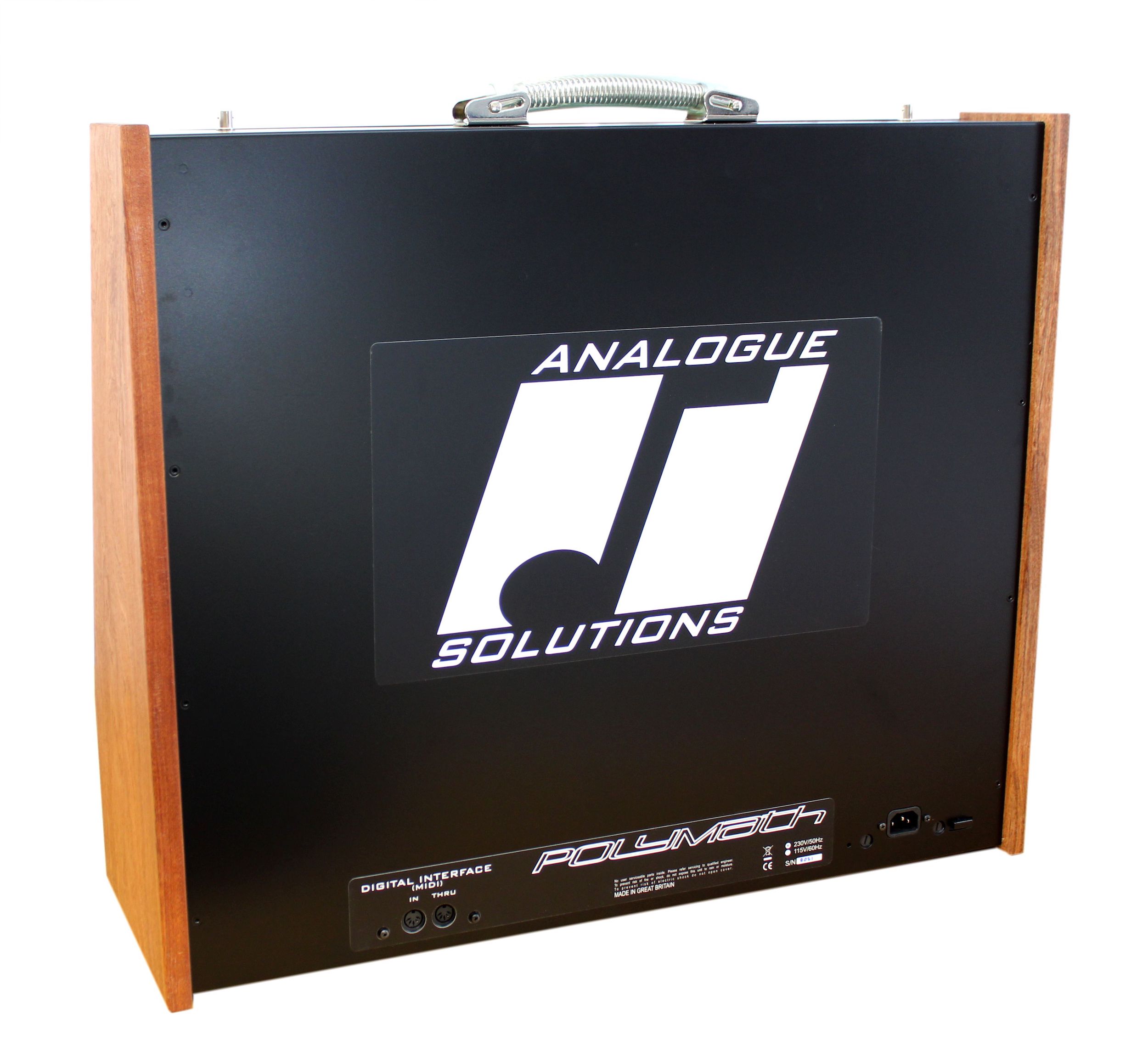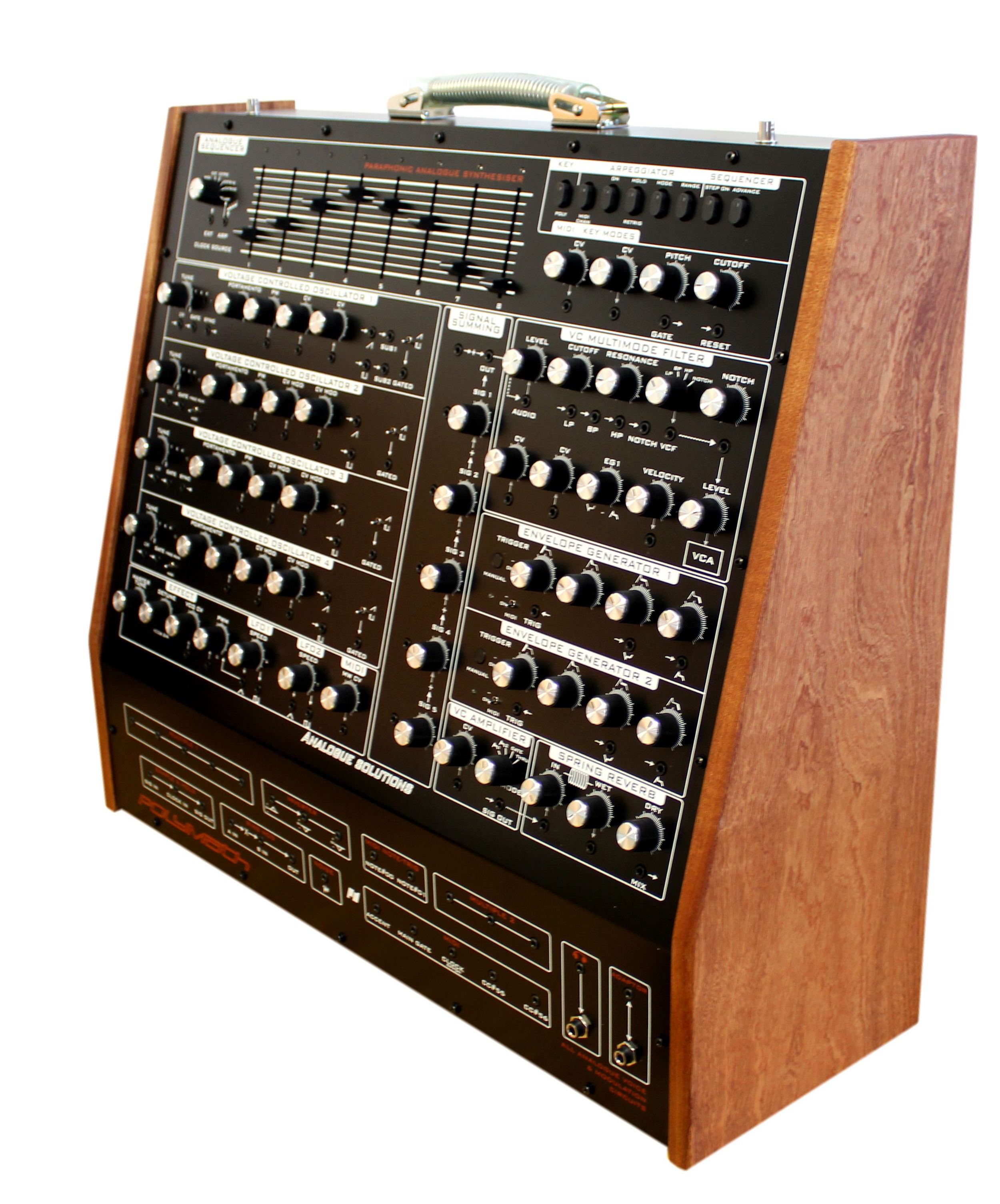Polymath
£ DISCONTINUED
Key Polymath Features
• 4 VCOs. Each have Pulse Width, Portamento, Saw wave, Square Wave, CV inputs, CV outputs, Sync. VCO1 has Sub-Osc output too.
• Multimode VCF based on (not a clone) the Oberheim SEM (LPF, BPF, HPF, Notch) with multiple CV control
• Audio input, to allow processing of external audio (vocals, for example, from your DAW, etc) through the filter
• 2 LFOs
• 2 ADSR Envelopes
• 8 Step Analogue Sequencer with sliders
• Arpeggiator – with Up, Down, Up/Down modes and Octave range
• Poly Mode (Paraphonic)
• Note Trig/ReTrig
• Unison Mode for mega-fatness
• Ring Modulation
• Sample and Hold
• Noise
• Multiples
• Adaptor
• Spring Reverb – a triple spring Accutronics unit is used.
• MIDI to CV Converter
• Mixer
• Inverter
• Headphone Amp
• VCA
• Hand built in Great Britain.
• Real Wood sides made by Lamond Design
• Solid steel and aluminium construction
• Carry handle
• Includes an assortment of patch cables
*Optional LED lamps are available separately
What is Paraphonic?
Ideally, for full ‘polyphony’ in an analogue synth you effectively need a complete analogue synth per voice. That is VCO, VCF, EG and VCA. For an analogue synth this is an expensive affair. So a few synths were Paraphonic (for example the Korg Monopoly). This mean that you still had a VCO per voice, but they shared a single VCF, VCA and EG. This provided cost and space savings.
Why is Polymath using the paraphonic method?
I chose to go Para’ not so much to save money or space, but because to make a truly polyphonic modular synth becomes a patcher’s nightmare. I know, I have done it using discrete modules. You end up with a sea of patch cables – and you can barely get to any of the synth’s knobs. I wanted Polymath to be a fully patchable, versatile analogue synth, as well as being polyphonic – not just a one trick pony. Going Para’ was a good comprise, allowing it to both be manageable (patching wise) and polyphonic.
There’s another reason it’s Paraphonic
The way synths such as the Korg Monopoly handle polyphony give it it’s own kind of sound (that can’t be put into words here). By making Polymath a paraphonic synth gives it that same sound characteristic that few other synths have.
In poly mode, as you press and release a single key, the synth will cycle through its four VCOs. If you have a slightly different setting on each VCO, as they cycle, you will get a different timbre as each note is played. This sounds pretty amazing – something you will be familiar with if you are lucky enough to own a Monopoly, Oberheim 4 Voice, etc.
Polymath is ‘Fully Modular’
– in the sense that every thing can be detached and repatched. It doesn’t have to be used as a ‘poly synth’ or a traditional ‘mono synth’. It can be repatched to do whatever you wish. Circuits can be isolated and used in conjunction with other modular synths or synths such as the Telemark.
The position of important patch points have been placed close together, where possible, so shorter patch leads can be used that won’t obscure too much front panel. For example, Mixer Out jack is placed next to the VCF Audio In jack. This means that it can be patched up to be a mono/poly synth with a minimal amount of cables or front panel-obsucring!
Some voltages are pre-patched in a sense, via quick and easy to use front panel pot’s or switches, but they can all be effectively removed from the circuit by setting them to ‘zero’
Some Additional Cool Features
Detune – This flattens VCO2 and sharpens VCO4, so that in Unison mod you can easily ‘fatten’ the sound.
There are ‘global’ PWM and Pitch Modulation controls, so that, if for example, you want to apply vibrato to all VCOs equally, you can do that with one cable rather than 4.
Spring Reverb – instantly transforms the sound. This doesn’t have to be patched in as a traditional effect, at the end of the signal chain. Sounds cool when inserted between the Mixer output and VCF input.
Polymath is a 4 voice paraphonic analogue modular synthesizer, with built in analogue step sequencer, arpeggiator and spring reverb.
The circuit designed is quite literally from the 1970s. It has a very old sound. And isull of character. Analogue synths of the 1970s had that just ever so slightly drifty sound that many would agree is so much more full of life than many of its digitally sanitized analogue synths.
Let’s deal with the two main labels in isolation, paraphonic and modular.
Paraphonic
Paraphonic is half way between a traditional monophonic and full polyphonic synth (though closer to the second).
Up to four note chords can be played, since it has four separate oscillators. However, it only has one filter and one amplifier section. Polyphonic synths usually have a filter/vca/envelope per voice/oscillator.
Traditionally this kind of polyphony was used to save money, since instead of four filters, four envelopes and four amplifiers (for a four note polyphonic synth), you only need one set share between the four VCOs. It would also save space as a much smaller PCB can be used and ultimately the reason was also to save cost.
However, this isn’t really the full reason we have chosen this implementation.
It is true money has been saved, but this saving has been used instead to invest in other extra features like the analogue sequencer and spring reverb.
The main reason is we chose paraphonic is we wanted this synth to be mostly modular. A fully patchable polyphonic modular synth is an absolute nightmare and a sea of patch cables. We know, because we have tried this! The patching is significantly reduced using the paraphonic method.
With paraphonic, you get the best of all worlds but still remaining practical. With a small number of patch leads you can set up a simple paraphonic patch and still be able to see the controls through the cables.
Also paraphonic implementation offers its own creative advantages over monophonic or polyphonic systems in the way voices can be cross-patched to cross-modulate. A paraphonic synth also has a different ‘sound’ to a full polyphonic synth, and being different is always good!
Modular
There are several terms like modular and semi-modular that are bandied about in the synth world. There is no standard in their meaning, and often they are used incorrectly (you only have to look at descriptions of old and new synths on forums, manufacturer web sites and places such as ebay). People have different opnions about how patchable a synth must be before it can be called modular.
There are many synths now that have a handful of sockets and get called modular. The term seems to be applied to synths that have ‘fixed’ circuits and those where sections can be swapped out. Some people think modular means that the circuits like VCOs must be able to be physically removed, swapped or changed with other circuits, like say, VCF. (For instance a Concussor or Doepfer modular) to be classed as modular.
Some say the synth can be called modular if the circuits are fixed and not swappable, but has a full complement of sockets.
I won’t debate which is the correct description of semi-modular or fully modular, but I would say Polymath can safely be classed as modular!
What we can say is that every circuit is completely independent, and can be patched where you want with just a few exceptions. The exceptions are there to reduce the amount of cable patching to a reasonable level. Where there is prepatching within Polymath, it can almost always be ‘cancelled’ by zeroing a control or flicking a switch.
Prepatched
The control voltages from the MIDI-CV converter are prepatched to each VCO, VCF, VCA, EGs. However, in many cases the signal can be switch out via a toggle switch.
In a similar way to above, some other signals are pre-patched to other circuits, but once again can be ‘turned off’ via a control or toggle switch.
The position of many key sockets has been carefully chosen so that in the most common patches the patch cables can be short, and will not ‘hang’ over the controls and obscure front panel vision. E.g., the VCF audio output socket is right next to the VCA audio input sockets. Since you’d normally patch these together we placed the sockets right by each other.
Introduction
Congratulations on buying the Polymath synthesiser. Polymath is part of the Analogue Solutions range of analogue music equipment. Polymath is a precision electronic musical instrument. It combines all the often needed music electronic circuitry to make a music synthesiser in one compact module.
No compromise has been made with the construction of Polymath. Cheaper options in parts have not been used;
Full rugged steel/aluminium case – no plastic mouldings
Good quality smooth potentiometers, fully sealed against dust
Good quality knobs with spun aluminium caps
High grade double-sided circuit board
High Quality 16bit DAC for MIDI-CV conversion
Very stable MIDI to CV
Stable analogue oscillators
Hand built by humans
True retro analogue voice and modulation circuits to give an authentic retro sound
1970s retro sound
Real thick quality wood side panels
Brief Overview
Polymath is a self-contained TRUE analogue synthesiser. The voice and modulation circuitry are entirely analogue, using all discrete and op-amp components.
Polymath uses a 12dB per octave multimode filter which has plenty of character.
Applications
MONO SYNTHESISER
Polymath is for use any time you need analogue sound effects, fat basses, screaming leads, beeps, tones, zaps, and all the other crazy sounds associated with analogue synthesis. Use in place of your boring digital synth’s and DSP soft synth’s. In Unison Mode the sound is HUGE!
EFFECTS PROCESSOR
Polymath has an audio input socket, so you can feed external sounds into the on-board analogue filters for analogue processing. This sound could come from an audio track on your DAW (for example a vocal track), from a sampler, or even, say a CD player.
Polysynth
In Poly mode you can play 4 note chords!
Drum Synthesiser
It is easy enough to patch this synth up to create all sorts of electronic percussion sounds, including, snares, kicks, hihats, metal sounds.








